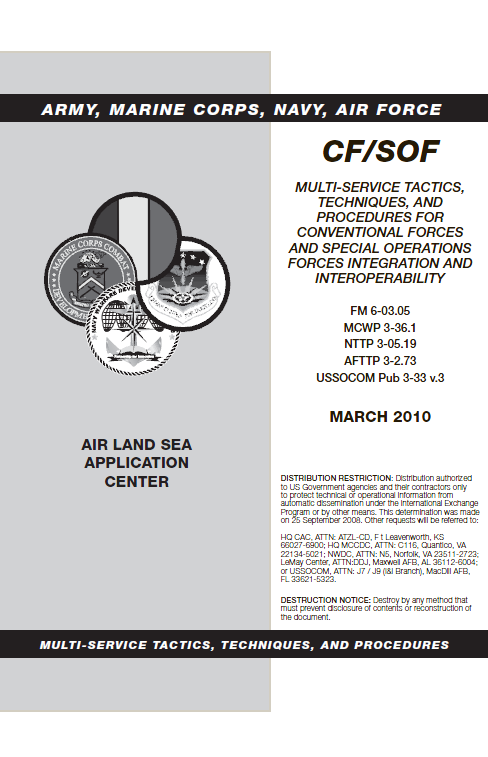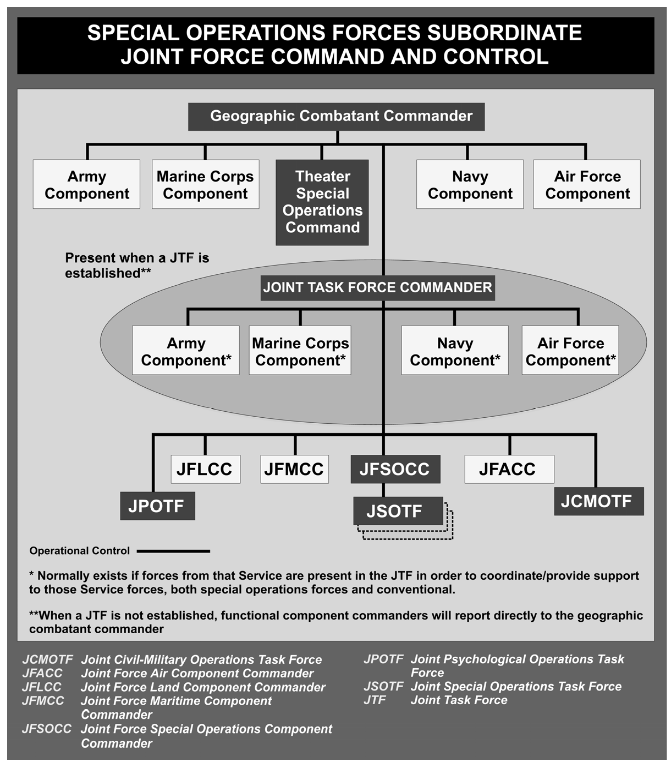MULTI-SERVICE TACTICS, TECHNIQUES, AND PROCEDURES FOR CONVENTIONAL FORCES AND SPECIAL OPERATIONS FORCES INTEGRATION AND INTEROPERABILITY
- 160 pages
- March 2010
- 4 MB
This multi-Service tactics, techniques, and procedures (MTTP) publication provides a comprehensive reference for commanders and staffs at the operational and tactical levels with standardized techniques and procedures to assist in planning and executing operations requiring integration of conventional forces and special operations forces (CF/SOF) occupying the same operational environment (OE). This MTTP publication serves as a reference to ensure coordinated multi-Service operations for CF/SOF integration and interoperability (I&I) in order to generate timely actions and increased opportunities while reducing the potential for fratricide. The guidance provided in this publication addressing command and control, maneuver, fire support, and force capabilities fills a doctrinal void and provides a single source document that will enhance effectiveness and improve inter-Service coordination.
The term conventional force (CF) is used throughout this publication since the term general purpose force (GPF) is not sanctioned in joint doctrine. CF is not to be confused with the acronym CF currently used to mean coalition forces in Operation IRAQI FREEDOM (OIF) and Operation ENDURING FREEDOM (OEF).
…
a. Until recently, CF/SOF units tended to operate in separate operational areas within the operational environment (OE), deconflicted by time and space. Generally, CF/SOF operations were planned and executed independently within a synchronized framework to support the joint force commander’s (JFC) overall plan. However, combat in Afghanistan (Operation ENDURING FREEDOM) and Iraq (Operation IRAQI FREEDOM) often produced situations in which CF/SOF operated simultaneously in the same operational area (e.g., Operation ANACONDA) with little time to plan and develop procedures. Although the capability to conduct joint operations has progressed significantly over the past 20 years, circumstances still arise in which actions against the enemy are delayed, opportunities are missed, and fratricide or near-fratricide incidents occur. The most significant challenges occur primarily in command and control (C2), maneuver, and fire support coordination. Issues surface due to a variety of reasons; however, lack of adequate liaison procedures is often the primary cause of challenges between CF/SOF units. The lack of standardized procedures; compatible systems; and lack of knowledge of CF/SOF capabilities, limitations, and culture create friction that impacts mission accomplishment.
b. While there are challenges in integrating CF/SOF in the same OE, there are also great opportunities for the JFC to exploit. CF integrated with SOF by a JFC creates unique capabilities for achieving objectives not otherwise attainable. Integration and interoperability (I&I) enable the JFC to take advantage of both Service and SOF core competencies and systems and effectively employ these capabilities in the overall operational plan. CF operations are characterized by lethal firepower, robust sustainment, extensive C2 capabilities, and relatively large numbers of personnel. SOF operations are characterized by small units of specially trained and selected personnel that conduct high-risk missions in hostile, denied, and politically sensitive environments. Effectively integrating CF/SOF actions can produce a greater effect at a higher tempo with less potential for fratricide than operating separately.
…


